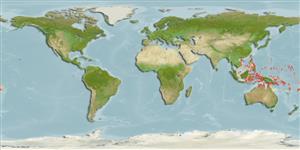>
Anguilliformes (Eels and morays) >
Congridae (Conger and garden eels) > Heterocongrinae
Etymology: Gorgasia: From Greek mithology, Gorgas, -ados = the Gorgone´s head (Ref. 45335); barnesi: Named for Anthony T. Barnes.
Eponymy: General William Crawford Gorgas (1854–1920) was an epidemiologist and Surgeon General of the US Army. [...] Anthony T Barnes was a colleague and shipmate of the authors aboard the research vessel ‘Alpha Helix’, from which the holotype was collected. [...] (Ref. 128868), visit book page.
Environment: milieu / climate zone / rango de profundidad / distribution range
Ecología
marino demersal; rango de profundidad 5 - 20 m (Ref. 90102). Tropical
Western Pacific: Indonesia, Philippines, Solomon Islands, Vanuatu and Papua New Guinea.
Tamaño / Peso / Age
Madurez: Lm ? range ? - ? cm
Max length : 121 cm TL macho / no sexado; (Ref. 33408)
Radios blandos dorsales (total) : 616 - 617; Radios blandos anales: 407 - 409; Vértebra: 201 - 219. This species slender, elongated, with the depth at the gills 1.1-1.6% of total length; a short head length, 11.2-14.1% of snout-anus length; mouth, as measured by front of upper jaw to rictus, is greater than 3.6% of snout-anus length; head pores are POM 5+4 and ST 2+1 (Ref. 58269).
Body shape (shape guide): eel-like.
Found in sand bottoms in about 5-20 m (Ref 90102).
Life cycle and mating behavior
Madurez | Reproducción | Puesta | Huevos | Fecundidad | Larva
Castle, P.H.J. and J.E. Randall, 1999. Revision of Indo-Pacific garden eels (Congridae: Heterocongrinae), with descriptions of five new species. Indo-Pac. Fish. (30):52 p. (Ref. 33408)
IUCN Red List Status (Ref. 130435: Version 2025-1)
Threat to humans
Harmless
Human uses
Herramientas
Special reports
Download XML
Fuentes de Internet
Estimates based on models
Preferred temperature (Referencia
123201): 27.2 - 29.3, mean 28.8 °C (based on 1004 cells).
Phylogenetic diversity index (Referencia
82804): PD
50 = 0.5001 [Uniqueness, from 0.5 = low to 2.0 = high].
Bayesian length-weight: a=0.00102 (0.00046 - 0.00225), b=3.06 (2.88 - 3.24), in cm total length, based on all LWR estimates for this body shape (Ref.
93245).
Nivel trófico (Referencia
69278): 3.5 ±0.5 se; based on size and trophs of closest relatives
Resiliencia (Referencia
120179): Bajo, población duplicada en un tiempo mínimo de 4.5-14 años (Preliminary K or Fecundity.).
Fishing Vulnerability (Ref.
59153): High to very high vulnerability (73 of 100).
🛈
